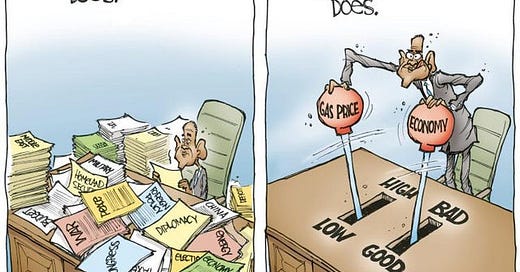Sree’s newsletter is produced w/ Zach Peterson (@zachprague). This is a 2012 cartoon about President Obama by John Cole (@ColeToon). This is what many Americans think President Biden does today.
🗞 TUNE IN: This week’s Sunday #NYTReadalong is with former NYT foreign correspondent and Ukraine expert James Brooke. You can watch live 8:30-10 am ET or via recording, at readalong.link/youtubeplaylist. The Readalong is sponsored by Muck Rack. Interested in sponsorship opportunities? Email sree@digimentors.group and neil@digimentors.group.
📺 My Digimentors team is looking for partners, speakers and sponsors for #SMWKND 2022. Get involved with my flagship event since 2011. Get in touch with Linda Bernstein, conference chair (linda@digimentors.group), to discuss how we can work together. Details coming to smwknd.com.
🎓 Vanessa Zamy, also known as “The Business Defibrillator,” has offered to present her free masterclass on how to grow a purpose-driven business (without burnout or sleep deprivation) to our Digimentors community. Please plan to join us on Tuesday, March 22, at noon ET. The class lasts about 75 minutes. Please sign up by Monday, March 21, via this link.
***
RUSSIA’S INVASION OF UKRAINE is in its third week, and it is a war being fought in the cities and villages of Ukraine, seemingly every corner of the internet, and in the media. I want to take a step back this week, and look at the information space — how people are talking, what to look for when being presented with seemingly factual information, and also provide some links that look at the bigger picture and how we got here.
It’s important to start with a base set of indisputable facts (or as close as you can get to indisputable). The information aspect of this war has ramped up significantly, and it’s crucial to be responsible with claims, facts, and sources.
I’ve seen a lot people calling it the first war of the social media era, but that’s of course not true — Syria, most of the war in Afghanistan, most of the war in Iraq, Russia’s 2014 of eastern Ukraine, and more come to mind. Frankly, when you hear that line, it’s a euphemism for “these are white Europeans, and it’s shocking to me to see white people fighting each other like this.” It’s a way of saying that this war is not “over there” like the many (many) wars of the last seven decades.
This war is Russia’s escalation of its 2014 invasion of eastern Ukraine — it simply is not the fault of The West. Those are Russian shells killing women and children in apartment blocks in cities the size of Philadelphia. Those are Russian soldiers launching attacks on nuclear facilities. Those are Russian tanks ravaging villagers (when they don’t get stuck in the mud).
This is a crucial point that is lost on a lot of people, so here are a couple of things to read and watch to simply gain a better understanding of how we got to where we are in Ukraine.
This unabridged Frontline interview with journalist and author Julia Ioffe (@juliaioffe) is the perfect place to start. The video is below, but I encourage you to watch on the PBS site with its useful interactive transcript tool (shoutout to series EP and Columbia Journalism School grad Raney Aronson, @raneyaronson).It’s all here. Ioffe knows contemporary Russian politics (and the personalities involved) as well as anyone, and this interview is remarkably informative. It’s required watching.
A no-fly zone is far more difficult and escalatory than many think. I’ll leave this to analysts, but as people increasingly support a no-fly zone in Ukraine, it’s important to understand exactly what that would mean.
The information environment right now is completely fluid, and people need to be vigilant. There’s a concerted effort by a predictable set of people to simply parrot Vladimir Putin’s talking points. Tucker Carlson and Glenn Greenwald are treading their familiar ground, but it’s about more than right-wing agitators doing what they do best.
Twitter, TikTok, and Facebook are all full of “firsthand accounts” and “threads from contacts” and other such things. While many of them are legitimate, many, many more are not. There is old footage, deep fakes, made-up personal accounts of events, and more.
Nice to see realtime debunking by journalists of fake information by officials, sometimes from third countries. Here’s Reuters White House editor Heather Timmons.


In addition — and this is important — people should also take official statements from the Ukrainian government with a grain of salt. Information wars go both ways, and just because your side says something you want to hear, doesn’t make it true.
Meanwhile, a reminder that journalists are doing all they can to bring us the stories we need to hear, see, read even as they’re under attack along with everyone else in Ukraine. See tweet by Susan Glasser of the New Yorker (she and NYT’s Peter Baker were guests on the #NYTReadalong in Dec. 2020).

- Sree / Twitter | Instagram | LinkedIn | YouTube / Cameo
A Word from Armory Square Ventures
Tech Tip w/ @newyorkbob: Ukraine’s Resilient Underground Remains Connected
By Robert S. Anthony
Each week, veteran tech journalist Bob Anthony shares a tech tip you don’t want to miss. Follow him @newyorkbob.
Despite the widespread devastation inflicted by the Russian military’s invasion of their country, Ukraine residents can still communicate with the outside world—just not very well. Vast areas of the country are now dark and without power, but locals have somehow managed to remain online and in touch.
While air raid sirens are audible for miles, they don’t reach far underground where many people are hiding. Google, in conjunction with the Ukrainian government, recently released an Air Alarm app which sends alerts to mobile devices if an air raid siren goes off in the user’s area.
While the Android app has obvious benefits, some users have complained that the alerts always sound off at maximum volume—thus adding more stress to an already bad situation. One app reviewer writes: “…I am jumping out of my body every time it starts. Please add sound regulation.”
In the capital city of Kyiv, many subway stations are now being used as bomb shelters—which is exactly what they were designed for when built by the old Soviet Union in the 1960s. At 346 feet deep, Kyiv’s Arsenalna station is actually the deepest in the world. Fortunately, all Kyiv subway stations support 4G cell phone service and wireless Internet, a godsend to those sheltered in them—as long as the data connections above hold out.
So, what’s the best way to reach someone in Ukraine who has access to the Internet? It depends on what they have on their mobile devices.
According to Statista, a research website, the most popular Android app in Ukraine as of November 2021—behind only Google’s Chrome and Gmail—was Viber, a communications app once famous for its walkie-talkie-like push-to-talk feature. Viber, which reaches almost 98 per cent of Ukraine’s Android users according to Statista, offers end-to-end data encryption to protect users’ privacy.
Telegram, which bills itself as “one of the 10 most downloaded apps in the world,” reaches almost 86 per cent of Android users in Ukraine according to Statista, and also offers multiple privacy and data-encryption features.
Both Viber and Telegram have self-destruct options which allow users to set an expiration timer on messages, after which they’re deleted from both the sender’s and recipient’s devices. Viber and Telegram are also available in Apple iOS versions and on Microsoft Windows and Apple Mac desktop and laptop computers.
The prognosis for Ukraine’s communications infrastructure is not good as the war damage continues, but for now the data is still flowing.
Read Something
This is a powerful piece of writing from Ed Yong. I think it’s important to look at the war in Ukraine in much the same way as the Covid19 pandemic, and that we do all that we can to avoid the myriad mistakes we’ve made. Rampant misinformation, a lack of leadership, and a host of other factors led to so much unnecessary suffering — it behooves us to learn this lesson and apply it immediately.


Odds & Ends
🩺 Be sure to check out our “She’s On Call” podcast, with surgeons Sujana Chandrasekhar, MD (@DrSujanaENT), and Marina Kurian, MD (@MarinaKurian) — watch the live show on YouTube, Facebook and Twitter.
🗞 TUNE IN: This week’s Sunday #NYTReadalong is with former NYT foreign correspondent and Ukraine expert James Brooke. You can watch live 8:30-10 am ET or via recording, at readalong.link/youtubeplaylist. The Readalong is sponsored by Muck Rack. Interested in sponsorship opportunities? Email sree@digimentors.group and neil@digimentors.group.
👀 Did we miss anything? Make a mistake? Do you have an idea for anything we’re up to? Let’s collaborate! sree@sree.net and please connect w/ me: Twitter | Instagram | LinkedIn | YouTube / Cameo.









